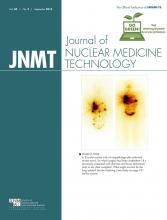Abstract
The aim of this study was to evaluate the assessment of the left ventricular ejection fraction (LVEF) in patients by gated IQ-SPECT. Methods: Twenty-eight patients were examined using gated 99mTc-sestamibi IQ-SPECT. Two different reconstruction datasets were created using the same projection data. The number of iterations, subsets, and gaussian filtering were based on 2 different recommendations from the manufacturer. For each dataset, end diastolic volume, end systolic volume, and LVEF were calculated using 4DMSPECT. A multigated planar equilibrium radionuclide ventriculography (MUGA) study with 99mTc-labeled red blood cells was used as a reference for the LVEF. Results: The values of the different datasets were tested using the Bland–Altman analysis method. The calculated mean and 95% limits of agreement for the LVEF when dataset 1 and 2 were compared were −1.1% and ±15% points; when dataset 1 was compared with MUGA, the mean was calculated to −3.1% points and ±17% points for the 95% limits of agreement. When dataset 2 and MUGA were compared, the mean was −4.2% and 95% limits of agreement of ±18% points. Conclusion: Neither of the gated reconstructed datasets analyzed with 4DMSPECT was comparable to LVEF estimated by MUGA, with a tendency to overestimate LVEF. However, large random variations of the end diastolic volume, end systolic volume, and LVEF between the 2 gated reconstructed datasets were found. The reconstructed datasets were not interchangeable. Thus, these values should only be used with great caution when evaluating the functional state of the heart.
Footnotes
Published online Jun. 25, 2015.







